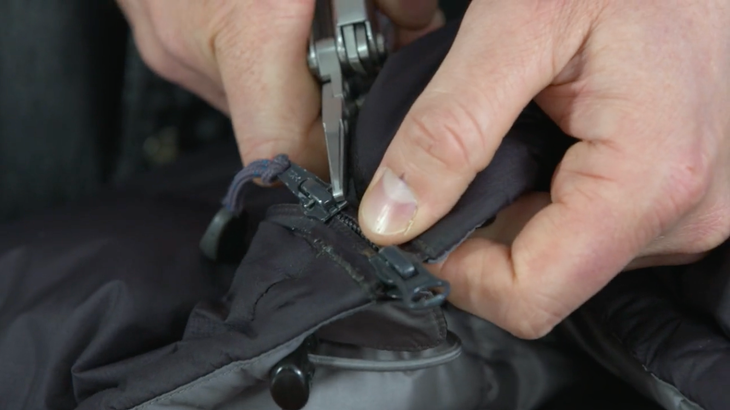Products You May Like
Get full access to Outside Learn, our online education hub featuring in-depth fitness, nutrition, and adventure courses and more than 2,000 instructional videos when you sign up for Outside+
Sign up for Outside+ today.
Repairing and maintaining your hiking gear will extend its lifespan, which is great both for your wallet and the planet. A busted zipper is no reason to trash your favorite jacket (or sleeping bag or pack). With a few tools, you can fix a zipper that separates or broken slider at home or in the backcountry.
The most common zipper failure is separation—when you zip the slider to the top, but the teeth don’t engage, leaving you exposed to chill or with your tent fly flapping in the wind. This type of failure is caused by a loose slider that’s unable to push the zipper coils together.
How To Fix a Zipper That Has Separated
- Start by engaging the zipper as normal, and zipping the slider an inch or two upward.
- Using the pliers on your multitool, pinch each side of the slider (one jaw of the pliers on the inside of the slider, one on the outside). Apply just enough force to gently squeeze the front and back of the slider closer together.
- Try the zipper again. If the teeth still don’t engage properly, repeat the above steps, this time squeezing the bottom of the slider, being careful not to overtighten. Continue pinching, applying more pressure as needed, until your zipper fastens properly.
When you’re back home, consider replacing the zipper slider for a more long-term fix.

Why Do Zippers Break?
Zippers have a thankless job, despite offering a critical function. Rarely do they receive much attention unless they actually break—which they tend to do at the worst possible time. Zippers most often fail for two basic reasons: overuse and underuse.
Overuse often results in the aforementioned separated zipper. Over time, the tension on the slider loosens to the point it can no longer apply enough pressure to pull the teeth together. Overuse can also result in a bent zipper track, especially if you’ve forced the zipper up while it was biting a piece of fabric. A visual inspection will reveal bent or broken teeth. At that point, it’s time to bring in your gear to a shop for a repair. If you’re in the backcountry, you may have to turn to old reliable duct tape as a temporary fix.
Underuse damage can occur when your gear is stored for an extended amount of time without maintenance. Gear-Aid makes zipper cleaner and lubrication oil which is perfect for when you are initially storing your gear or when it emerges from dormancy. It’s also a good part of routine gear maintenance. Checking in on your zipper health at least once a year is a good idea across all your gear—backpacks, tents, jackets, first-aid kits, and anything else that relies on zippers.
It’s worth noting that most zippers tend to fail slowly, over a series of weeks or months. Zippers tend to be highly reliable and can withstand a lot of abuse. That’s pretty impressive for a device that hasn’t changed much since its initial invention in 1851. If your zippers start snagging or causing gaps in sections of teeth, give them a tune-up. A little bit of preventative maintenance can save you time and money by avoiding a trip to your local gear shop (tailors and alteration stores can often repair zippers as well).
